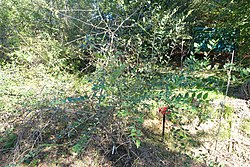| Prunus ramburii | |
|---|---|
 | |
| Scientific classification | |
| Kingdom: | Plantae |
| Clade: | Tracheophytes |
| Clade: | Angiosperms |
| Clade: | Eudicots |
| Clade: | Rosids |
| Order: | Rosales |
| Family: | Rosaceae |
| Genus: | Prunus |
| Subgenus: | Prunus subg. Prunus |
| Section: | Prunus sect. Prunus |
| Species: | P. ramburii |
| Binomial name | |
| Prunus ramburii | |
| Synonyms | |
Prunus amygdalinaWebb | |
Prunus ramburii (Spanish : endrino de Sierra Nevada, "sloe of Sierra Nevada") is a species of plant in the family Rosaceae. [2] It is endemic to Spain. It is threatened by habitat loss. [1]
